Virtual Gallery
Welcome to JSI's Virtual Gallery. This historical sampling of Sacred Art, by no means comprehensive, facilitates contemplating Joseph's unique role in Salvation History - as an image is worth 10,000 words. If you would like to add an artwork, please email JSI.
The Holy Family with a Little Bird
This iconic circa 1650 oil on canvass by the great Spanish artist Bartolomé Esteban Murillo (1617-1682) is an oil on canvas depicting a domestic scene of the "hidden life" of the Holy Family. Filled with tenderness and warmth it shows the Virgin Mary winding a skein of thread and watching the Christ Child, who leans on Joseph while he plays with a little bird and a dog. The leading role of Joseph in this image corresponds to the increased devotion to him during the 1600s. Crafted in a strong chiaroscuro style, this classic exalts ordinary family life and work -- symbolized by Mary's sewing basket and Joseph's carpenter's tools. First listed in various private collections, this work eventually found its way to Queen Isabel de Farnesio´s collection in 1746; then, it was taken to Paris by José I, were it was part of the Napoleonic Museum from 1810 to 1817; then it found its home at the Prado Museum in 1819.
Baptized on January 1, 1618 in Seville, only a day after his birth, Murillo is celebrated as one of Spain's finest Baroque painters. Trained under Juan del Castillo, Murillo began his art career in a naturalistic tenebrist style influenced by Francisco de Zurbarán. His early works were characterized by dramatic contrasts of light and shadow, which became a hallmark of his style. By the mid-1640s, Murillo gained significant recognition through a series of 11 paintings on the lives of various Franciscan saints.
Murillo's "The Flight into Egypt" (circa late 1640s) is a masterful oil on canvas that vividly captures the biblical narrative of the Holy Family's urgent escape to Egypt to evade King Herod's assassination decree. Murillo's choice to depict Mary and Joseph as life-size, highly realistic figures infuses the scene with a profound sense of humanity and immediacy. Mary’s watchful gaze over the sleeping infant Jesus and Joseph’s concerned expression portray them as relatable, ordinary parents caught in a moment of peril and protection, which is a hallmark of Murillo’s accessible and empathetic style. The painting’s composition along the coastal “way of the sea” road situates the viewer within the journey itself, emphasizing the vulnerability and determination of the Holy Couple. Murillo’s use of warm, earthy tones and soft lighting enhances the emotional warmth and intimacy of the scene, inviting contemplation of faith and hope amidst adversity -- a central theme of JSI's inaugural theme, "Joseph, Beacon of Hope for the Pilgrim Church," as well as the 2025 Jubilee Year's theme "Pilgrims of Hope."
In comparison to other depictions of the Flight into Egypt, Murillo’s version is grounded in a more direct human experience, avoiding overt symbolic elements in favor of emotional resonance and naturalism. The painting not only narrates a sacred story but also serves as a meditation on parental love, protection, and the quiet strength found in moments of crisis. Overall, Murillo’s work of art stands out for its compassionate portrayal of the Holy Family, its technical mastery, and its ability to convey a timeless narrative with both dignity and warmth, making it a significant and moving work in the canon of Baroque religious art.
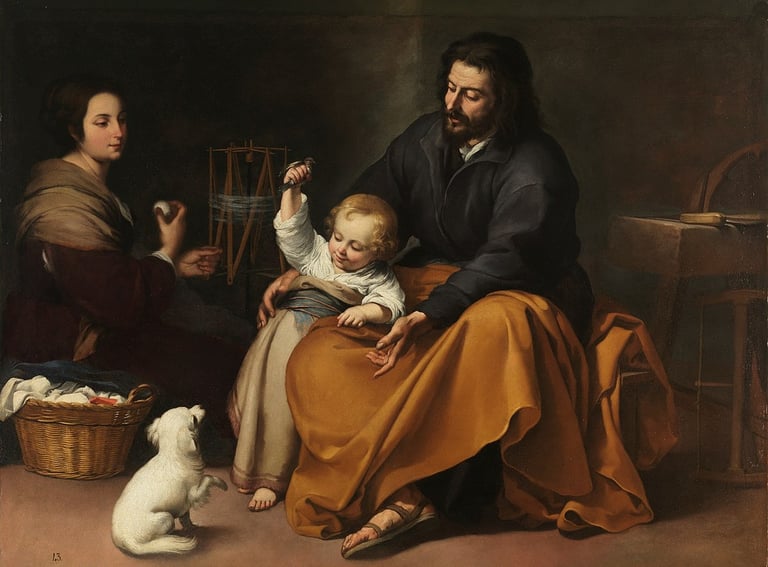


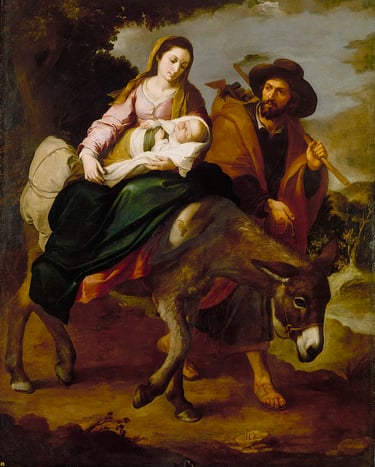
St. Joseph, Patron of the Universal Church
This gorgeous and very rare gem is "hidden" in the St. Joseph Chapel located in the south transept (Ecclesia) of St. Bernard Church in Mount Lebanon, Pennsylvania. It is perhaps the greatest Josephine artwork of the 20th century in the United States, painted by the Polish master, Jan Henryk de Rosen (1891-1982), who is famous for his huge murals and mosaics - two of which are among the largest in the world: one in the dome of the New Cathedral of St. Louis in Missouri and the other is his Christ in Majesty mosaic in the dome of the Basilica of the National Shrine of the Immaculate Conception in Washington, DC, measuring an astounding 3,610 square feet which he completed in 1959 while a professor of church art at the nearby Catholic University of America. Done in a traditional Byzantine style of "Christ Pantocrator" (or Christ, Ruler of All), some commentators have quipped that this enormous mosaic's "mean" look is meant to put the fear of God into the politicians of Washington, DC.
Th reredos featured here in Mount Lebanon, painted behind a marble and limestone altar, however, reflects the massive simplicity of the Romanesque crypt chapel, featuring Joseph in the center holding in his left hand a Ship (symbolic of the Church as the "Bark of Peter") and he is flanked by Doctors of the Eastern Church on his right and Doctors of the Western Church on his left. His right hand shows the two natures of Christ (humane and divine) and the Trinity, three persons in one God. These great doctors of the church lived in the early centuries of Christian history. Due to their closeness in time to Christ, the fountainhead of all Truth, their writings are especially venerable and cast their luster over succeeding centuries of Christians. They each had things to say about St. Joseph the Patron of the Universal Church. The first eight Doctors of the Church are especially noteworthy as they are also known as the "Ecumenical Fathers" - teachers and preachers of special preeminence in the Early Church. They are, from left to right: St. Athanasius the Great (293-373 AD), St. Gregory of Nazianzen (329-389 AD), St. John Chrysostom 345-407 AD), St. Basil the Great (330-397), Pope St. Gregory the Great (540-604 AD), St. Ambrose (340-397 AD), St. Augustine (354-430 AD), and St. Jerome (340-420 AD).
Born in Warsaw, which was then part of the Russian Empire, De Rosen began to paint at age 33 and his work quickly caught attention and he was commissioned to paint murals in the Armenian Cathedral in Lviv in 1929 by its Archbishop and later he was commissioned by Pope Pius XI to paint four murals at the chapel of Castel Gandolfo. De Rosen grew up a Calvinist like his beloved parents and later in his life came into full communion with the Catholic Church. DeRosen's father, Jan, also a historical and genre painter, painted for the last Czars of Russia, Alexander II and Nicholas II.
If you would like to learn more about this beautiful painting, you can watch this interview with Mike Aquilina (author of St. Joseph and His World) on the Cuppa Joe show here wherein Mike gives an excellent explanation along with much of its Josephological significance.
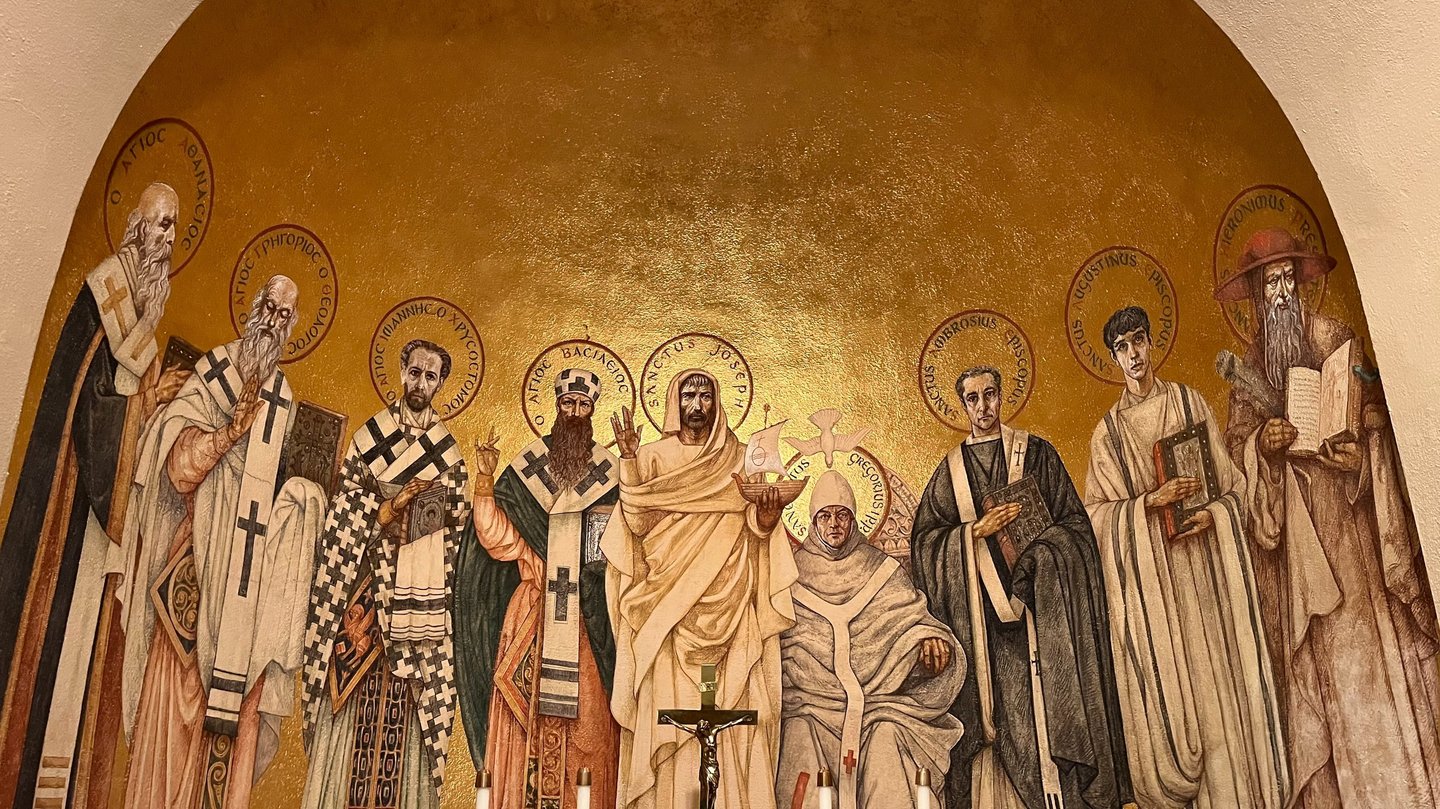

The Most Ancient Images of Joseph
This mosaic icon of Joseph, depicted with dark hair, found at the Basilica of St. Mary Major in Rome, is the most ancient image of Joseph in any church in the world. It was commissioned during the reign of Pope Sixtus III just after the Council of Ephesus in 431 AD, which affirmed Mary's title of Theotokos. The angelic Annunciation to Joseph seen here complements the one to Mary that is also depicted.
A gravestone in St. Hippolytus' catacomb in Rome (200s AD) and St. Celsus' sarcophagus in Milan (300s AD) depict Joseph similarly but as a "beardless young man" (cf. Joseph the Silent by Michel Gassier, p. 46, Scepter. 2017).
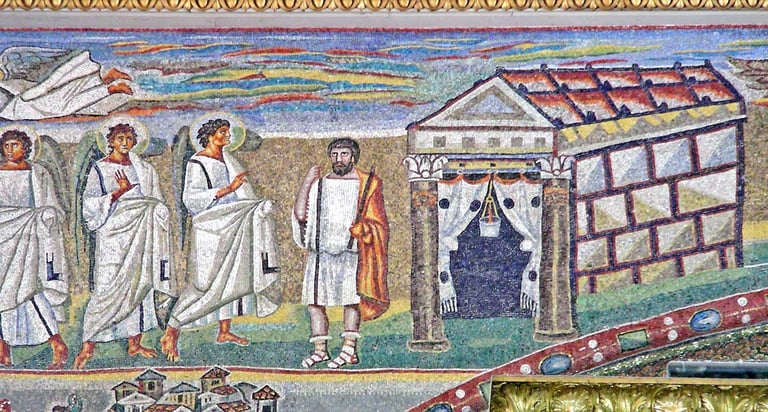

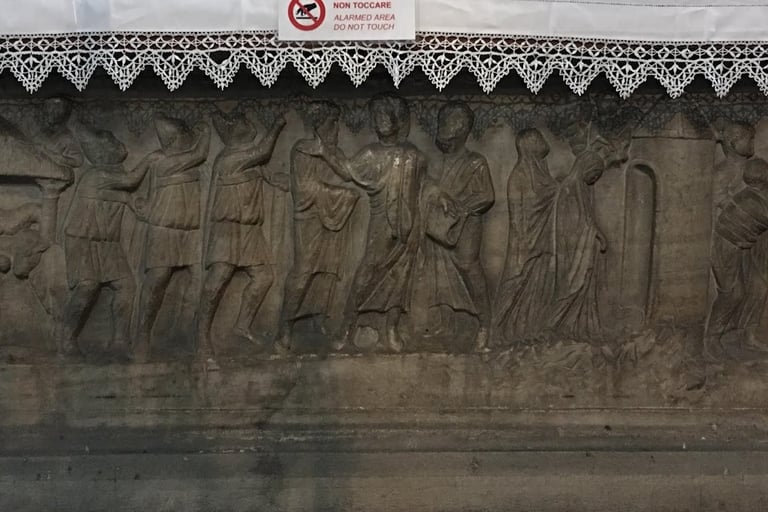

Nativity Icon
Dated around the 7th century, this folk art icon, characterized by the round faces and highly stylized figures, created using the medium of encaustic, depicts Mary and the Baby Jesus as central to the Nativity scene while a troubled, elderly Joseph is shown isolated at the bottom left corner, chin in hand. Housed at St. Catherine's Coptic Orthodox Monastery in Sinai, Egypt, this image comes from the influence of the apocryphal book, the Protoevangelium of James, which was accepted mostly in the Christian East but condemned in the Christian West due to certain non-biblical embellishments such as a midwife, hymen checking, and the hypothesis that Joseph was an elderly white-haired widower with many adult children when he betrothed the Virgin Mary. This image became the prototype for how to depict Joseph throughout most of the East's iconography.
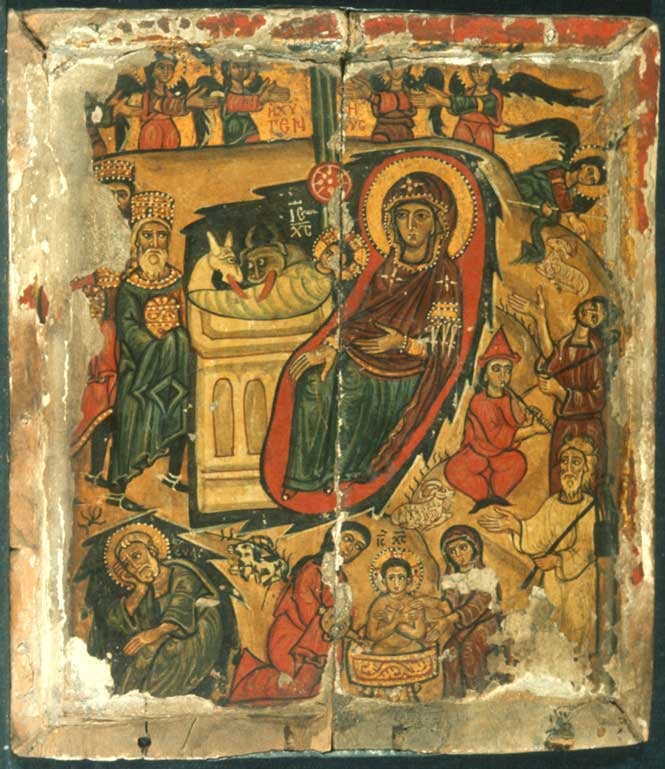

St. Joseph, Patron of the Universal Church
This striking 1893 painting by Giuseppe Rollini can be found inside the Sacred Heart Basilica in Rome, Italy at a side altar. It shows St. Joseph (together with the Holy Family) as Patron of the Church. Pictured holding the child Jesus and the lily (symbolizing his great purity) in one right hand, his other hand extends in blessing over St. Peter's Basilica, representing the Universal Church. The banner “ITE AD IOSEPH” is an invitation to all to “Go to Joseph” (Genesis 41:55), the loving father of Jesus, asking for his intercessory prayer. Rollini was commissioned to paint this beautiful painting 23 years after Pope Pius IX proclaimed St. Joseph as the "Patron of the Universal Church" on December 8, 1870. Originally constructed in honor of St. Joseph, this church was later dedicated instead to the Sacred Heart of Jesus.
Born in Italy, Giuseppe (Joseph) Rollini (1842-1904) studied painting in Turin at the Academia Albertina under Gastaldi. He is best recognized for is sacred art paintings, many of which were commissioned for churches associated with the Salesian order, founded by St. John Bosco; in fact, Rollini is the artist who painted the official portrait of Don Bosco himself, which reflects his close ties with the Salesian community and its evangelical mission.
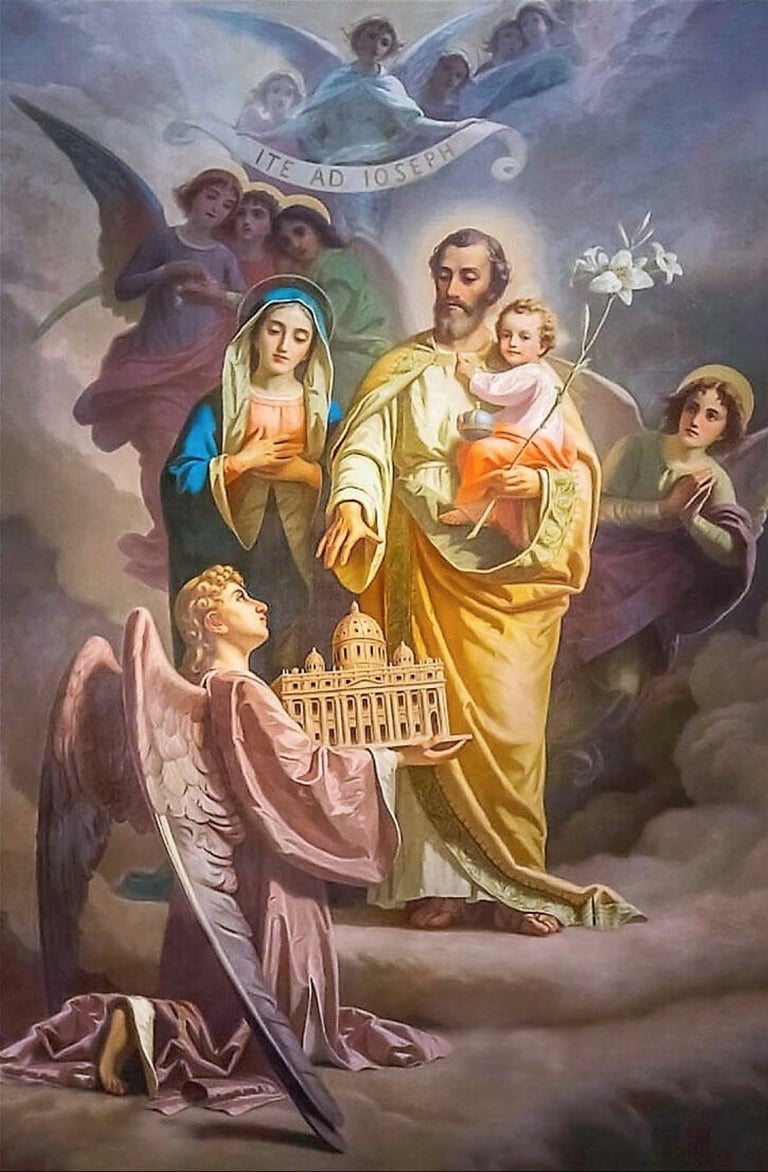

St. Joseph and the Christ Child Enthroned with Four Angels
School of Cuzco (Peru), 18th century
Commentary by Rev Joseph F. Chorpenning, OSFS, STL, PhD
Regal crimson and gold dominate this majestic painting of St. Joseph and the Christ Child Enthroned with Four Angels. The robes of both Joseph and Jesus are densely stamped with gold leaf in floral or feathery patterns—a hallmark of the School of Cuzco. A “cloth of honor” of rich crimson brocade fabric with a gold border hangs behind Joseph and Jesus.
Joseph is portrayed as handsome, youthful, and vigorous. He holds his traditional attribute of the flowering staff, which represents his divine election as the husband of the Mother of God. Through this most sublime and sanctifying marriage, Joseph became the earthly father and guardian of the Son of God. Joseph’s unique relationship with Mary and Jesus is the foundation for his preeminence among the saints—a primary theme in the papal magisterium since Joseph’s proclamation as Patron of the Universal Church in 1870.
Joseph’s crown symbolizes variously the heavenly glory which is his inheritance for the “good works” he performed as Guardian of the Redeemer (cf. the Council of Trent’s decree On Justification); his royal lineage as a member “of the house and family of David” (Luke 2:4); and his sharing by marriage in Mary’s royal title and privileges.
Since the Middle Ages, Mary had been depicted surrounded by angels as the Seat of Wisdom (sedes sapientiae), whose lap served as the Christ Child’s throne. Here Joseph’s arm and lap form Jesus’s throne. The four angels flanking Joseph’s lobulate throne may also allude to the four occasions when, according to Matthew’s Gospel, the saint received divine communications relayed by angelic messengers.
The cartouche at the lower right specifies the indulgences granted for praying seven Our Fathers and seven Hail Marys in honor of the Seven Joys and Sorrows of St. Joseph—a devotion which originated with the Capuchins in early 16th century Italy.
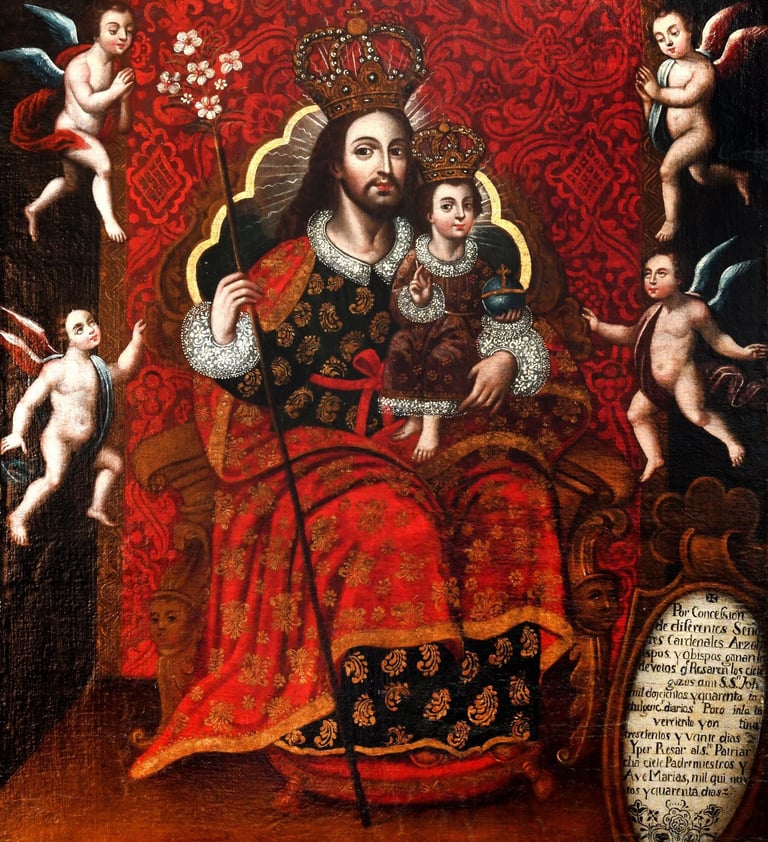

The Patronage of Saint Joseph
A richly detailed Baroque oil on canvas, Patrocinio de San José was painted around 1740 by Bolivian artist Gaspar Miguel de Berrío (1706–1762), a leading figure of the Potosí School active primarily in the Viceroyalty of Peru (modern Bolivia), is housed in the Museo Nacional de Bellas Artes in Santiago, Chile. Renowned for his complex religious iconography blending Spanish Baroque with local influences, Berrío’s work exemplifies colonial Latin American sacred art and reflects the deep veneration of Saint Joseph throughout 18th-century Ibero-America.
Joseph occupies a central, exalted throne within an angelic composition that includes John the Baptist, Joachim, and Anne. These figures are linked by a flowing banner to their daughter, the Theotokos and Queen of Heaven, who in turn is connected by a ribbon banner to Joseph, the Prince of Heaven. Above them radiates the Holy Trinity, highlighting Joseph’s unique intimacy with the divine mystery. Joseph’s lily symbolizes his holy purity, while his crowning by seraphim and cherubim emphasizes the theological significance of the heavenly protection granted to Christ’s virgin father, Joseph, here depicted in his elevated status as protector and Patron of the Universal Church.
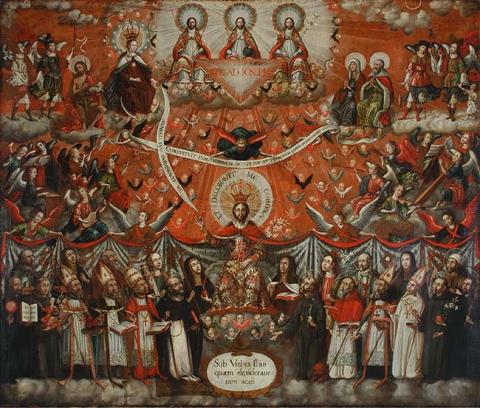

Señor San José
This striking and unique Baroque Neo-Spanish oil on canvas, anonymously painted between the 18th and 19th centuries, is housed in the Chapel of San José at the New National Basilica of Santa Maria de Guadalupe in Mexico City. The New Basilica, inaugurated on October 12, 1976, serves millions of pilgrims annually.
Saint Joseph is depicted standing in heaven with welcoming open arms, his patronal mantle upheld by two archangels, crowned by seraphim, and bearing the Holy Spirit as a dove on his chest—symbols of divine protection over the Missionary Congregation of Saint Joseph, known as "Los Josefinos," founded in Mexico City in September 1872 by Father José María Vilaseca (1706–1910), originally from Spain. Vilaseca may have been inspired by artists from his homeland or local Mexican painters.
A similar work, Patrocinio de San José, painted circa 1740 by Bolivian artist Gaspar Miguel de Berrío and housed in the Museo Nacional de Bellas Artes in Chile, shares iconographic and devotional traits, reflecting the widespread veneration of Saint Joseph throughout colonial and post-colonial Ibero-America.
(Sources: Universo Barroco Iberoamericano and the Josefinos Facebook pages)
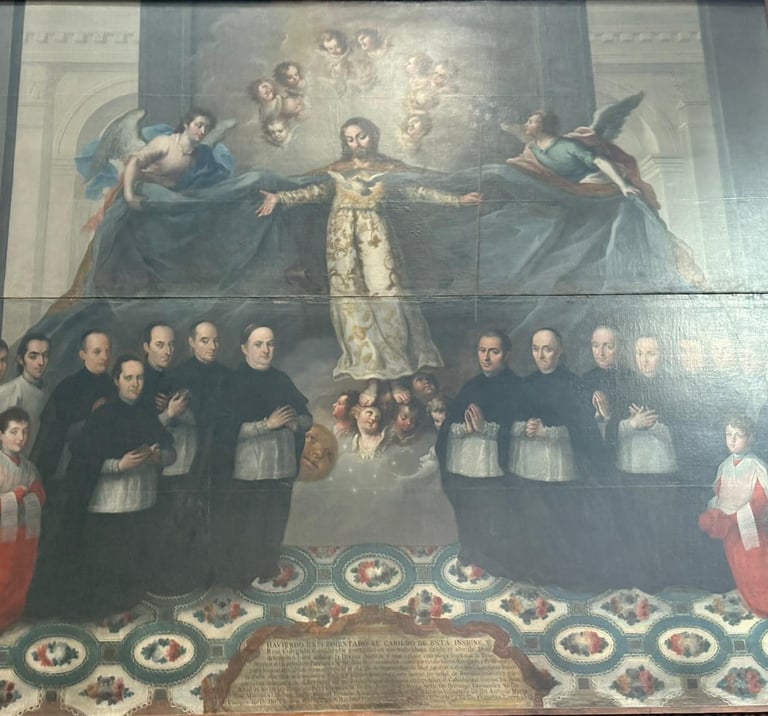

Saint Joseph The Worker and Terror of Demons
By Cecilia Lawrence, BS (Art), aka Theophilia: renowned for her beautiful icons "St. Joseph the Worker" and "Terror of Demons," which appeared in Consecration to St. Joseph, her artwork is inspired by Christ’s Incarnation and her love for theology and history.
Depicting saints as relatable people through vibrant iconography and historical realism, her amazing portfolio has been showcased for a million people on DeviantArt and Etsy. Her artistic philosophy is encapsulated by her favorite two mottos: “To contemplate and to give to others the fruits of contemplation” (from the Dominican Order) and “Fight to the death for truth, and the Lord God will fight for you” (Sirach 4:28).
Cecilia was the very first special guest interviewed on the Cuppa Joe show on the Josephology YouTube channel, which you can see here. To learn more about her amazing Sacred Art, Icons, and more visit her here.
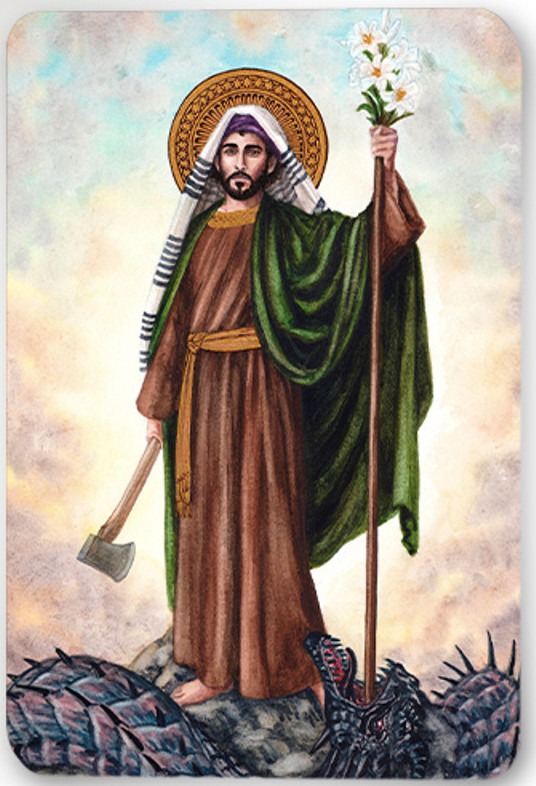

St. Joseph
Gwyneth Thompson-Briggs, an award-winning sacred artist steeped in the Renaissance and Baroque styles to reveal the glory of God, her art decorates churches, schools, and private homes throughout the Americas and Europe. She sees art as part of the Church’s mission to evangelize.
During high school, she studied under Tony Ortega at the Art Students League of Denver. Afterwards she earned a BFA at the Rocky Mountain College of Art and Design and also holds advanced degrees in Physics and Engineering.
In 2014 Gwyneth moved to New England to study the Boston School technique under Paul Ingbretson; in 2017, she was asked to create a painting for Pope Emeritus Benedict XVI; in 2019, her and her husband, Andrew, launched Gwyneth Thompson-Briggs Sacred Art as their full-time family business in St. Louis with their four children. Gwyneth was a special guest on an episode of the Cuppa Joe show, which you can see here. To learn more about her heavenward artwork, visit here studio here.
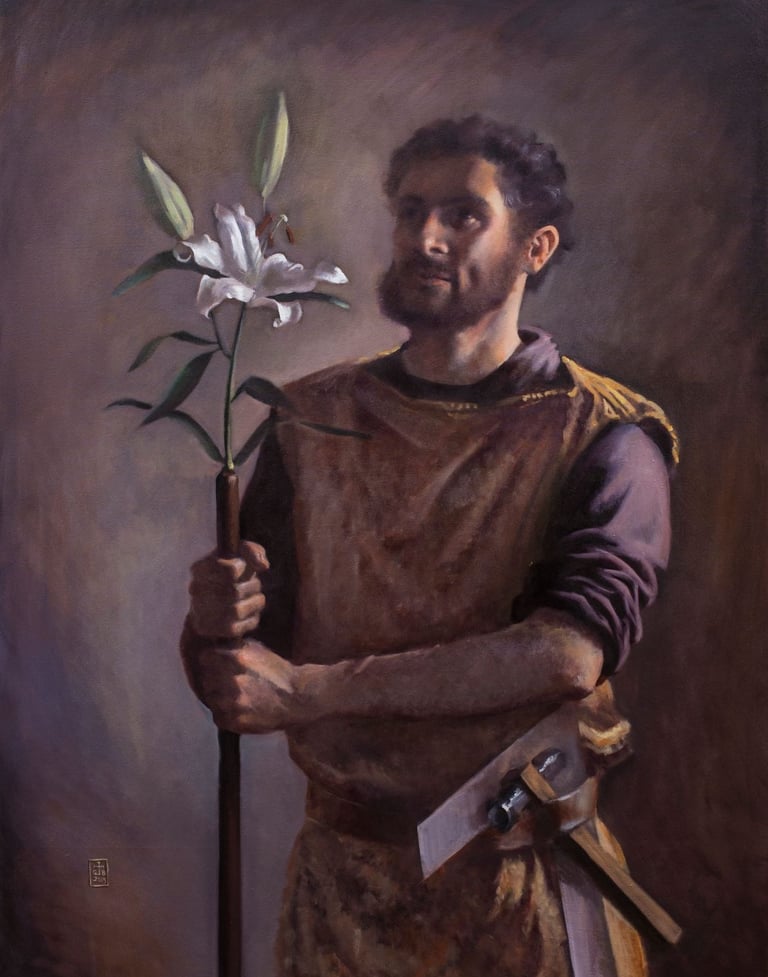

Matthew 20:23
This painting by Blair Gordy Piras was commissioned by Very Rev. Donald Calloway for the book Consecration to St. Joseph. It is an interpretation of Jesus’ answer to Salome the mother of the "Sons of Thunder" in Matthew 20:23: "To sit at my right hand and at my left is not mine to grant, but it is for those for whom it has been prepared by my Father." The Christocentic painting depicts Jesus enthroned in glory, and with Mary and Joseph on his right and left. Jesus is surrounded by the four evangelists represented as the four living creatures from Ezekiel and Revelation. Trained in the Catholic tradition of Sacred Art in Florence, Italy, Blair was honored to be the first artist in residence on campus at Franciscan University of Steubenville in 2017. For more information, visit the Blair Barlow Fine & Sacred Art Studio site here.
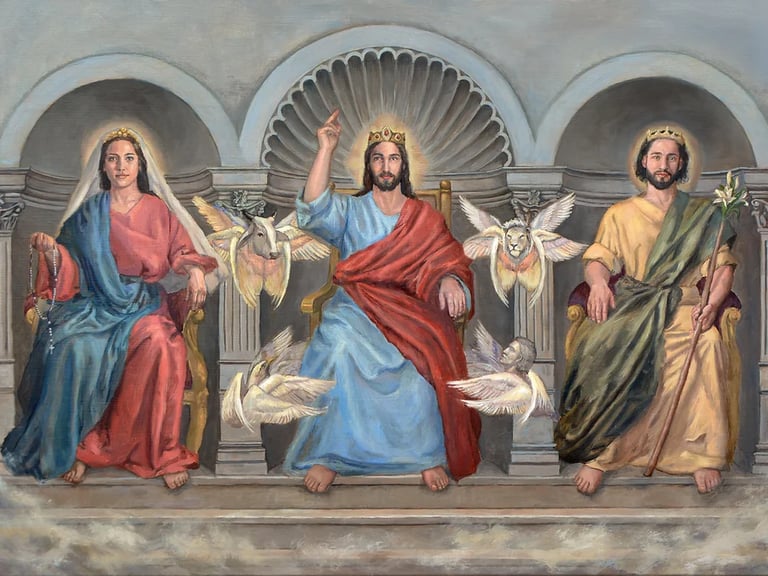

The Nativity
Melchers' The Nativity stands out for its naturalism and emotional resonance. It eschews grandiosity for a more relatable portrayal of a pivotal moment in Christian theology. By grounding this sacred event in everyday life, Melchers invites viewers to connect with the humanity of Mary and Joseph, making the divine more accessible.Overall, The Nativity is celebrated not only for its artistic merit but also for its thoughtful engagement with biblical themes, reflecting Melchers' broader artistic philosophy that emphasizes authenticity and emotional truth in religious art
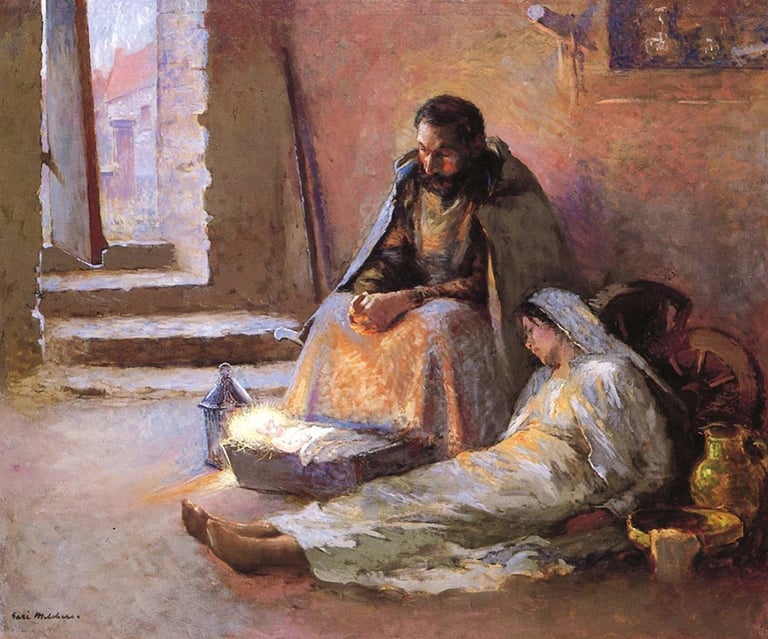

Christ Crowning Saint Joseph
Francisco de Zurbarán (1598–1664) was a prominent Spanish painter of the Baroque period, renowned for his religious meticulous works that predominantly feature Biblical saints in his style of tenebrism, a technique that employs strong contrasts between light and dark, which he adapted from Caravaggio, giving his art a dramatic intensity and spiritual depth that is striking and emotive.
One of Zurbarán's masterpieces is "Christ Crowning Saint Joseph," created around 1640, which exemplifies his mastery of light and showcases Joseph's honor as the earthly Guardian of the Redeemer and his glorification at the eschaton of his earthly life. The composition is characterized by its serene-yet-powerful imagery, with Christ bestowing honor and glory upon His loving earthly father, who is depicted with humility and reverence - an exemplar model father and husband in the Christian tradition. This eschatological work captures well the essence of Zurbarán's artistic vision - combining realism with spiritual symbolism - to create a compelling narrative on canvas. "Christ Crowning Saint Joseph" is housed in the Museo de Bellas Artes in Seville, Spain, where it continues to be celebrated as one of Zurbarán's masterworks, reflecting both his technical skill and deep Christian faith.
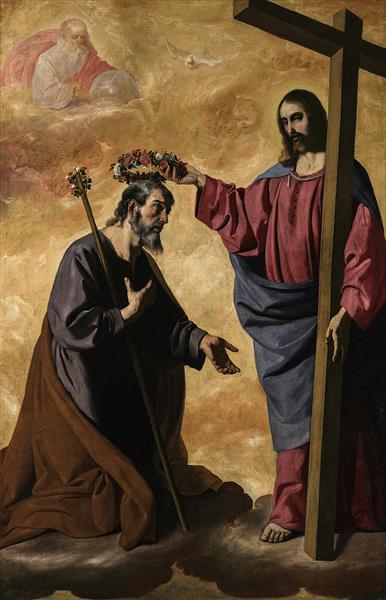

Old Joseph, Young Joseph
This anonymous image, likely AI-generated, made its Internet debut in 2021 during the Year of Saint Joseph. Engaging and provocative, it could be used to show Joseph's lifespan, or, more likely (judging from the articles this image appears with), to illustrate the two different traditions surrounding Joseph - one tradition says he was 80 and a widower when he betrothed Mary while the other tradition says he was younger and a virgin when he married Mary. Like the two traditions, these two images come from two different artists, though both are Baroque masters:
Right: "Saint Joseph with the Child Jesus" by Bartolomé Esteban Perez Murillo (1618 - 1682), depicts Joseph aged around his 30s. The full piece, located at Christie's London, shows Joseph holding a lily and walking hand-in-hand with Jesus who appears to be around three.
Left: "St. Joseph" by Guido Reni (1575 – 1642), is a lovely piece in which the full work depicts Joseph alone, reading a book, presumably Scripture, his left hand raised beneath his bluish-violet tunic and rustic-reddish overcoat, as if caught in a prayerful moment of awe. It is located at the National Gallery of Ancient Art in Rome, Italy.
Reni's classical idealism and luminous colors blends quite well here with Murillo's naturalistic style that emphasizes warmth and humanity. Reni significantly influenced Murillo (especially with his work The Immaculate Conception), which, interestingly, illustrates how artistic traditions can also evolve through cross-cultural exchanges within the Christian art community.
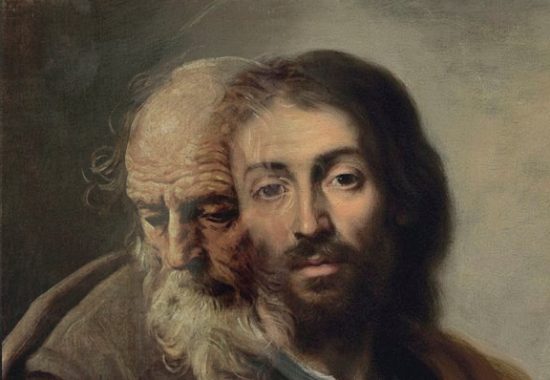

Saint Joseph, Custodian of the Two Hearts
This impressive artwork on canvas by Norman Faucheux is located at the Adoration Chapel at Nicholls State University in Thibodaux, Louisiana. Based in Louisiana, Faucheux's works of art are often characterized by a unique blend of Renaissance and Byzantine styles, featuring intricate details, rich colors, and textures that bring Biblical imagery and Catholic traditions to life.
Faucheux, an art teacher at St. Thomas More School in Louisiana, began to see art in a new light during his first year at LSU where his passion for art began to go to a higher level, culminating in spending two years aboard in the painting program at the Sacred Art School of Florence, Italy. For more information about this artwork or its artist, visit him here.
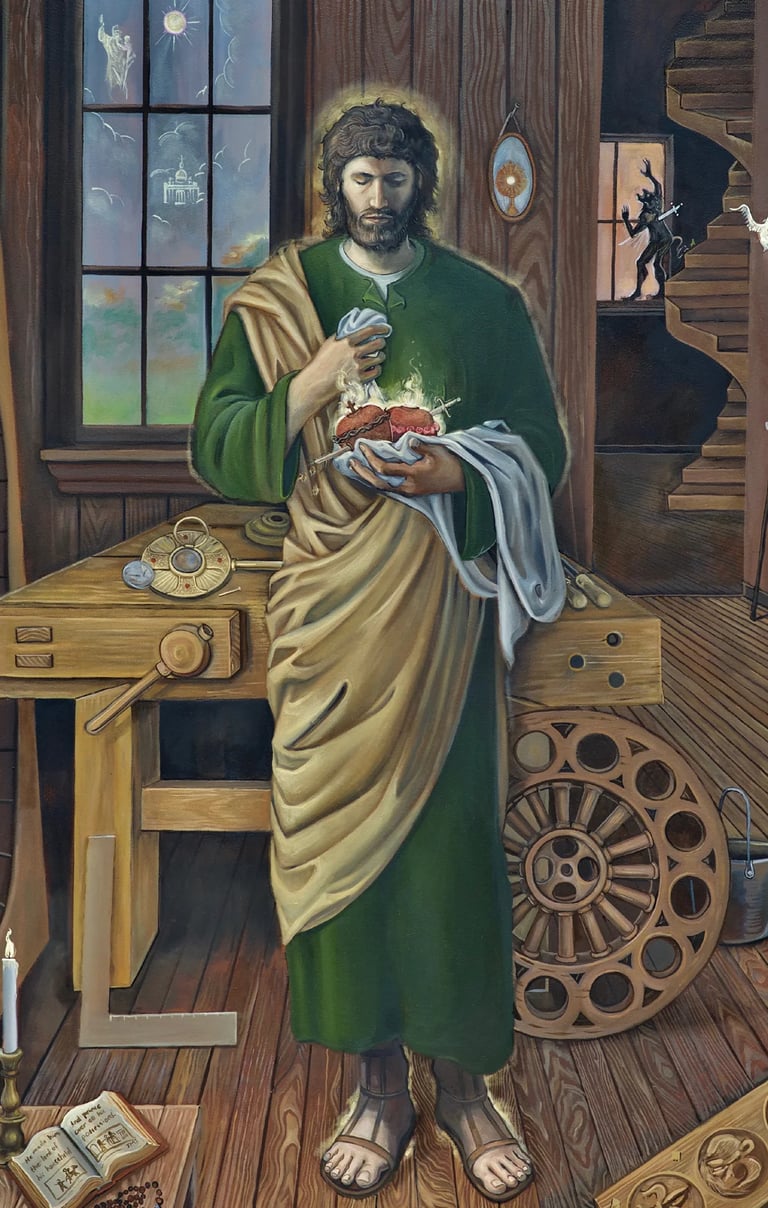

St. Joseph and the Christ Child
Created in 2019, this Renaissance-inspired painting by Jacob Zumo depicts Joseph's strength, wisdom, and bravery as a "Hidden King" in the line of King David as he cradles the infant Jesus, the King of kings and Lord of lords. The Christ Child, wrapped in pure white and bearing His own crown, holds a cross, foreshadowing His future mission for the redemption of the world. One of the many artworks commissioned for the book Consecration to St. Joseph, this depiction emphasizes the tenderness and protective nature of Joseph as a model father figure within Christian tradition, as highlighted in Pope St. John Paul II's apostolic exhortation titled "Guardian of the Redeemer." To learn more about this artwork or to visit Zumo's studio click here.
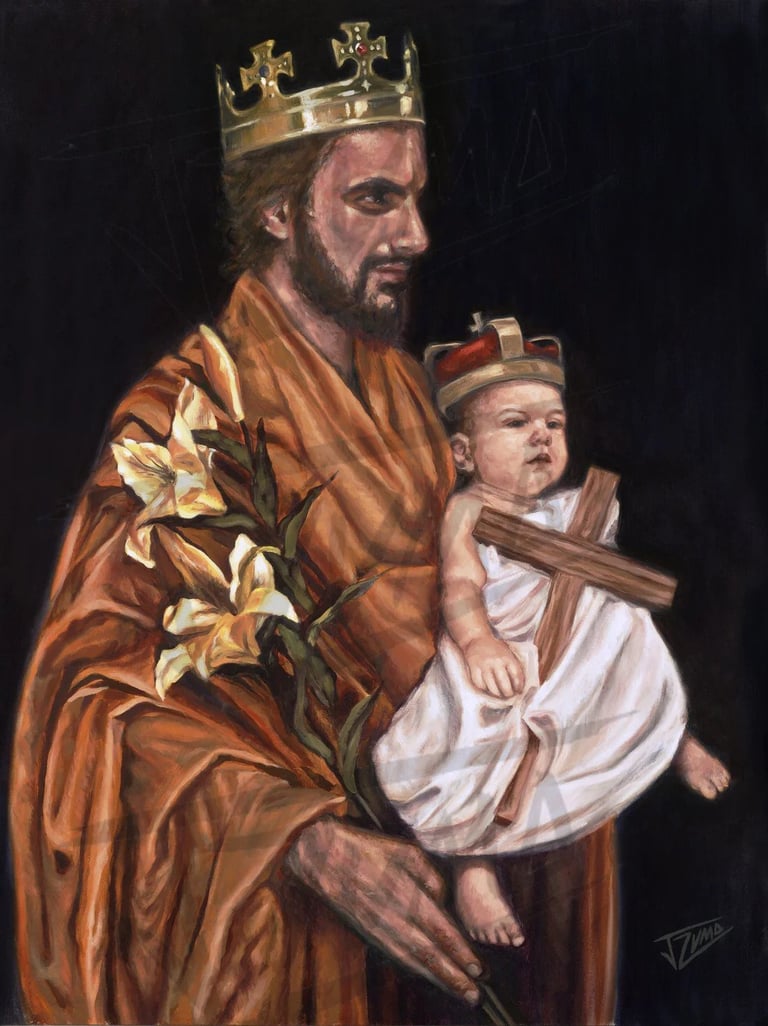

Explore
Discover Joseph of Nazareth's role in God's plan of salvation history!
Email:
© 2024. All rights reserved.
Contribute
Submit papers, be a guest speaker, host a symposium!
Pray
For our Society to "increase" and always glorify God!